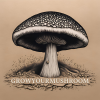Ultimate Guide to Mushroom Farming for Beginners: Step-by-Step Success Blueprint
Mushroom farming for beginners is an exciting and profitable way to step into the world of agriculture with minimal space and investment. Whether you’re looking to grow mushrooms at home or start a small-scale business, this guide will help you understand the basics, from choosing the right type of mushroom to setting up your first grow. Let’s explore how easy and rewarding mushroom cultivation can be! What is Mushroom Farming? Mushroom farming is the cultivation of mushrooms for consumption, medicinal use, or commercial purposes. Unlike traditional farming, mushrooms are grown in controlled environments, often indoors, using substrates like straw, sawdust, or compost instead of soil. Why is Mushroom Farming Gaining Popularity? Mushroom farming is becoming increasingly popular due to several reasons: Brief History and Global Overview of Mushroom Cultivation Mushroom cultivation dates back to ancient China and France, where it was initially practiced for both food and medicinal purposes. Over time, it spread worldwide and has now become a large-scale commercial industry, especially in countries like China, the USA, the Netherlands, and India. Today, mushrooms are not only valued as a delicacy but also as a functional food with health benefits. 2. Understanding Mushrooms: Types and Characteristics Edible Mushrooms Commonly Cultivated Some of the most widely grown edible mushrooms include: Medicinal and Exotic Mushrooms Certain mushrooms are prized for their medicinal properties: Toxic Mushrooms to Avoid Not all mushrooms are safe to consume. Some toxic varieties can cause serious health problems or even be fatal. Key examples include: Proper identification is essential when foraging or cultivating mushrooms to avoid accidental poisoning. 3. Benefits of Mushroom Farming Nutritional and Health Benefits of Mushrooms Mushrooms are highly nutritious and provide a variety of health benefits: Economic Advantages for Small and Large-Scale Farmers Mushroom farming offers financial opportunities for farmers at all levels: Environmental Benefits and Low Carbon Footprint Mushroom cultivation is an eco-friendly farming option: 4. Types of Mushroom Farming Methods Indoor Mushroom Farming Outdoor Mushroom Farming Vertical and Container-Based Mushroom Farming 5. Common Mushroom Varieties for Beginners Oyster Mushroom (Pleurotus ostreatus) Button Mushroom (Agaricus bisporus) Milky Mushroom (Calocybe indica) 6. Mushroom Farming Requirements Ideal Climate and Environmental Conditions Space and Infrastructure Needed Essential Tools and Equipment 7. Understanding the Mushroom Life Cycle Spore Formation Mycelium Growth Fruiting Body Development 8. Selecting Mushroom Farming Substrates Commonly Used Substrates Preparing and Sterilizing the Substrate Factors to Consider When Choosing a Substrate 9. Mushroom Farming Step-by-Step Process Preparing the Growing Area Spawning: Introducing Mushroom Seeds Incubation Period Fruiting: Mushroom Growth Phase Harvesting Mushrooms Properly 10. Key Mushroom Farming Techniques Bag Cultivation Method Tray Cultivation Method Log Cultivation Method 11. Environmental Control in Mushroom Farming Managing Temperature and Humidity Light and Airflow Requirements Pest and Disease Prevention 12. Common Challenges in Mushroom Farming Fungal and Bacterial Infections Poor Yield Causes Handling Contamination 13. Post-Harvest Handling and Storage Cleaning and Sorting Mushrooms Storage Techniques for Fresh Mushrooms Drying and Packaging for Long Shelf Life 14. Marketing and Selling Mushrooms Local Market Opportunities Selling to Supermarkets and Restaurants Starting an Online Mushroom Business 15. Mushroom Farming as a Profitable Business Investment and Startup Costs Profit Margins and Break-Even Analysis Scaling from Small to Commercial Farming 16. Organic and Sustainable Mushroom Farming Benefits of Organic Mushroom Farming Sustainable Practices and Waste Management Certifications for Organic Produce 17. Mushroom Farming in Different Climates Tropical Climate Considerations Mushroom Farming in Cold Regions Indoor Solutions for Harsh Weather 18. Essential Tools and Mushroom Farming Kits Mushroom Grow Bags and Trays Sterilization and Monitoring Tools Starter Kits for Beginners 19. Learning Resources for Mushroom Farmers Training Programs and Workshops Books and Online Courses Joining Mushroom Farming Communities 20. Future Trends in Mushroom Farming Smart Farming and Automation Growing Demand for Medicinal Mushrooms Innovations in Mushroom Packaging and Processing 21. Summary Mushroom farming is a profitable, eco-friendly, and accessible agricultural business suitable for both beginners and experienced farmers.It offers quick returns, low investment, and high market demand while contributing to sustainable farming practices. Whether you choose to grow mushrooms on a small scale or build a commercial farm, the process involves: With the rise of organic farming, smart agriculture, and health-conscious consumers, the future of mushroom farming is full of opportunities. By using proper training, essential tools, and modern techniques, anyone can succeed in this growing industry. Starting your journey in mushroom farming may seem challenging at first, but with the right knowledge and a little patience, it can become a highly rewarding activity—both personally and financially. Whether you’re growing oyster, button, or milky mushrooms, understanding the basics like choosing the right variety, maintaining hygiene, and creating the right environment is key to your success. This beginner’s guide is just the first step. As you gain experience, you’ll discover better techniques, increase your yield, and unlock the full potential of mushroom cultivation. Happy farming Frequently Asked Questions (FAQs)
